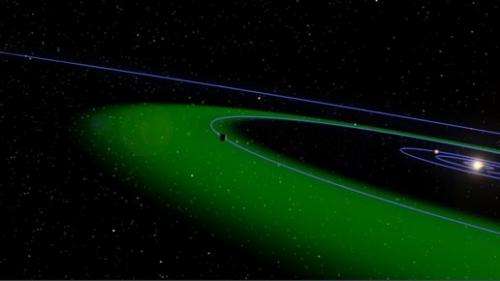February 11, 2016 report
Model suggests carbon dioxide could cause loss of planetary water as easily as increased solar radiation

(Phys.org)—A trio of researchers affiliated with the Max Planck Institute for Meteorology and Princeton University has created a computer simulation that shows that a large increase in atmospheric carbon dioxide can cause a loss of planetary water as easily as an increase in solar radiation. The team has published the details of their model and what it showed in Nature Communications.
In searching for life on other planets, space scientists look for other planets that exist in what has become known as the habitable zone—where they are in a place deemed just the right distance from their star to prevent being too hot or too cold, or too dry. But now, they may have to take another factor into consideration this new research suggests—the "moist greenhouse" as the team calls it. This is where a planet loses its water to the atmosphere, and then to space due to an increase in greenhouse gases.
The researchers came to this conclusion by starting with a standard global climate model of a simplified plant similar to Earth in some ways, such as distance from the sun and spin rate, but very different in others—the surface was completely covered in water, its orbit was perfectly circular and it was not tilted on its axis. Also, there were no land masses, ice caps or water currents and the global ocean was only 164 feet deep. The researchers put in these constraints to make their model simple, and to best utilize computer resources. To see the impact of carbon dioxide, the researchers slowly increased levels in the atmosphere, and found that once it reached approximately 1,520 parts per million, planetary instability arose—water evaporated from the ocean into the atmosphere as surface temperatures rose to 135°F which led to a moist greenhouse. That allowed more ultraviolet light to strike the water molecules breaking them into hydrogen and oxygen—the oxygen then recombined but the nitrogen dissipated into space. Over the course of several million virtual years, the planet lost all of its water, leaving a barren landscape.
The model shows, the team suggests, that such scenarios should be taken into consideration when making decisions about which planets to study in the search for life on other planets. They also note that the model does not reflect the possible future of our own planet because the levels of carbon dioxide necessary to cause such a situation would be far higher than we humans will ever likely cause to come about.
More information: Max Popp et al. Transition to a Moist Greenhouse with CO2 and solar forcing, Nature Communications (2016). DOI: 10.1038/ncomms10627
Abstract
Water-rich planets such as Earth are expected to become eventually uninhabitable, because liquid water turns unstable at the surface as temperatures increase with solar luminosity. Whether a large increase of atmospheric concentrations of greenhouse gases such as CO2 could also destroy the habitability of water-rich planets has remained unclear. Here we show with three-dimensional aqua-planet simulations that CO2-induced forcing as readily destabilizes the climate as does solar forcing. The climate instability is caused by a positive cloud feedback and leads to a new steady state with global-mean sea-surface temperatures above 330 K. The upper atmosphere is considerably moister in this warm state than in the reference climate, implying that the planet would be subject to substantial loss of water to space. For some elevated CO2 or solar forcings, we find both cold and warm equilibrium states, implying that the climate transition cannot be reversed by removing the additional forcing.
Journal information: Nature Communications
© 2016 Phys.org




















